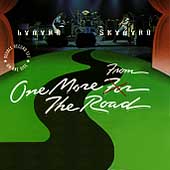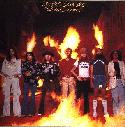
 At 26, Steve Gaines already had as much professional experience as the Skynyrds.
Since 1971, he had been in a variety of groups, including one with Mitch Ryder,
and had a recording experience both in Memphis and Macon. But as he drove home
after the Kansas City show, Steve's career appeared stalled. No one in Skynyrd
said anything about the performance until about two weeks later when Steve got a
call from Ronnie asking him to join Skynyrd in Myrtle Beach, South Carolina.
At 26, Steve Gaines already had as much professional experience as the Skynyrds.
Since 1971, he had been in a variety of groups, including one with Mitch Ryder,
and had a recording experience both in Memphis and Macon. But as he drove home
after the Kansas City show, Steve's career appeared stalled. No one in Skynyrd
said anything about the performance until about two weeks later when Steve got a
call from Ronnie asking him to join Skynyrd in Myrtle Beach, South Carolina.
Ronnie said:"I expect we'll all be in Steve's shadow one day. This kid is a writing and playing fool. He's already scared everybody(in the band) into playing their best in years."
Steve's positive attitude and energy had a tremendous impact on the band, especially on Allen Collins, whose raves about the Kansas City performance were mainly responsible for landing the younger Gaines the third guitar spot.
With the recording of the live album only a month away, Steve sent June in marathon cramming and jamming sessions. The month of rehearsals was the first time since pronounced that the group had extensive time to prepare for a recording.
Unlike some of the arenas Skynyrd were playing, the ornate Fox Theatre in Atlanta was a small venue, chosen for its sound. With the addition of Gaines and the needed rehearsals time, the band was primed for a classic performance, and that they gave.
Skynyrd's live reputation had evelated them critically into the rare stratosphere otherwise occupied by such as The Rolling Stones and the by-now shattered Allman Brothers Band. At the Gator Bowl benefit for Presidential candidate Jimmy Carter in July, it was Skynyrd who were the main attraction, and in August, their performance at Britain's Knebworth Festival garnered raves at the expense of the headlining Stones (according to the New Music Express, Sounds, and other Brit- rock weeklies).
The burgeoning Skynyrd live rep also reflected a number of extramusical changes before and subsequent to the live recording. Ronnie had grown tired of the press accounts that dwelled on the band's rowdy, drunken, redneck image. The group struck the confederate colors as backdrop and stopped using "Dixie" as their intro. Ronnie also began to take care of his person on and off-stage, including weaning himself off the whiskey bottle. (The birth of his daughter, Melody, certainly had something to do with this.)
Some of the other band members, though, had not learned from past experiences.
 On Labor Day weekend, as the band took some time off before the
upcoming tour, both Allen Collins and Gary Rossington crashed their cars
in seperate incidents. While the law came down on them with hefty fines
for Driving Under The Influence,this was nothing compared to Ronnie
VanZant's public wrath. Ronnie called the incidents "just plain stupid"
in the Los Angeles Times, Circus Magazine and anywhere else he was
interviewed. His railings would culminate in the lyrics to the epochal
"That Smell," written and performed during the tour that followed the
release of One More From The Road.
On Labor Day weekend, as the band took some time off before the
upcoming tour, both Allen Collins and Gary Rossington crashed their cars
in seperate incidents. While the law came down on them with hefty fines
for Driving Under The Influence,this was nothing compared to Ronnie
VanZant's public wrath. Ronnie called the incidents "just plain stupid"
in the Los Angeles Times, Circus Magazine and anywhere else he was
interviewed. His railings would culminate in the lyrics to the epochal
"That Smell," written and performed during the tour that followed the
release of One More From The Road.
As a result of the accidents, the band was forced to delay the start of the tour, and the resulting publicity virtually mocked the new calmer image Ronnie was attempting to engender.
 Irregardless, One More From The Road quickly entered the Top 10, achieving
gold, then platinum status, and with this success came such fringe benefits as
trading their tour bus for a private plane and even more time to prepare for
their next studio album.
Irregardless, One More From The Road quickly entered the Top 10, achieving
gold, then platinum status, and with this success came such fringe benefits as
trading their tour bus for a private plane and even more time to prepare for
their next studio album.
Skynyrd entered Criteria Studios in Miami with producer Tom Dowd in April, 1977 with enough material to complete an album. However, once the sessions were done, disagreements broke out during the mixing process, and the group hit the road to fulfill touring commitments none-too-thrilled with the recordings thus far.
Skynyrd spent the summer of '77 on their most impressive tour to date, doing a series of outdoor stadium concerts across America. Introduced to the strains of "Theme From The Magnificent Seven," a revitalized, confident Lynyrd Skynyrd "overpowered most of the other acts," said the San Francisco Examiner. "A tidy mixture of country standards, hard-rocking originals and unconcerned euphoria gained for Skynyrd what none of the other bands were able to match: a straight forward triumph." The other artists on the bill were Santana, Peter Frampton and group, and The Outlaws. The critical praise and overwhelming crowd response was repeated at every stop on the tour.
The band then booked themselves into Doraville's Studio One to finish the album begun at Criteria. When they arrived they found engineer Rodney Mills, but Tom Dowd was still commited to a Rod Stewart project in Toronto. Dowd asked Los Angeles engineer Barry Rudolph to go to Atlanta to be "his representative" for at least the projected week Dowd would be away, and subsequently the producer gave the engineer the green light to record a song.
Rudolph had engineered Waylon Jenning's classic album Are You Ready For The Country, and this not only made him welcome in the studio with Skynyrd, but a bull session with Ronnie regarding Jennings and fellow C&W hero Merle Haggard resulted in the group recording Haggard's "Honky Tonk Night Time Man." This went so well that, before Rudolph left at the end of the week, the group had re-recorded "You Got That Right" and "That Smell" (both recorded at Criteria).
As it turned out, Tom Dowd was not asked to return to the project, and Ronnie, engineers Rodney Mills and former roadie/now Skynyrd soundman Kevin Elson put the finishing touches on the recordings, mixing both the Studio One and remixing the Criteria tracks used for the album. No producer credit was listed on the released LP.
 Ronnie had often said that Lynyrd Skynyrd were "just street people," trying to
write "common songs for the common people." Combine that with the turbulence the
group had been through since inception, and they had the title of the new album,
Street Survivors, complete with a cover photo showing the group standing tall
while everything around them is in flames.
Ronnie had often said that Lynyrd Skynyrd were "just street people," trying to
write "common songs for the common people." Combine that with the turbulence the
group had been through since inception, and they had the title of the new album,
Street Survivors, complete with a cover photo showing the group standing tall
while everything around them is in flames.
By the fall of 1977, the momentum of twelve years of touring, rehearsing, and recording had brought Skynyrd a maturity and musical excellence to match a new level of popularity. Street Survivors was the first Skynyrd album to be certified gold (over 500,000 copies sold) upon release, and all indications were that it would easily become the band's most popular ever. Skynyrd was to headline New York's Madison Square Garden in November as part of their most ambitious headline tour ever, "Tour Of The Survivors," and this was going to symbolize the fulfillment of Ronnie and band's long-time dream. But it was not to be.
Street Survivors was released October 17, 1977, and October 20, during the first week of a project three month tour, Lynyrd Skynyrd's private 1947 Convair 240 turbo prop plane ran out of gas due to "an engine malfunction of undertermined nature," causing it to crash in a forest near McComb, Mississippi while attempting to land. Steve Gaines, Cassie Gaines, assistant and road manager Dean Kilpatrick, and Ronnie VanZant were all killed instantly upon impact. The rest of the band entourage all suffered serious injuries that, in some instances, caused permanent physical damage.
The irony of the plane crash is that it brought Lynyrd Skynyrd more national publicity than ever before, tragically branding the group with the reckless image their Survivors tour was designed to change.
That the accident happened just as Lynyrd Skynyrd appeared to be receiving broad-
based acceptance and only shortly after Steve Gaines was fully integrated is one
of the saddest tragedies in rock 'n' roll. The "Legend" of Lynyrd Skynyrd is what
the band had yet to achieve when they boarded that plane. While we celebrate
their musical legacy, we can only imagine what was yet to be.
© Rick Clark
Thanks to www.skynyrd.com for some of the pictures
Information on this site were copied from the booklet that followed The Box Set